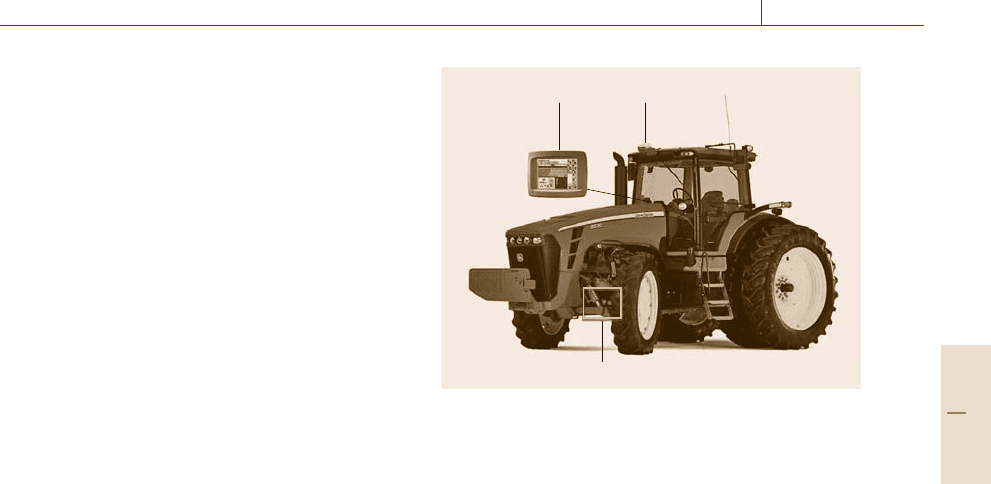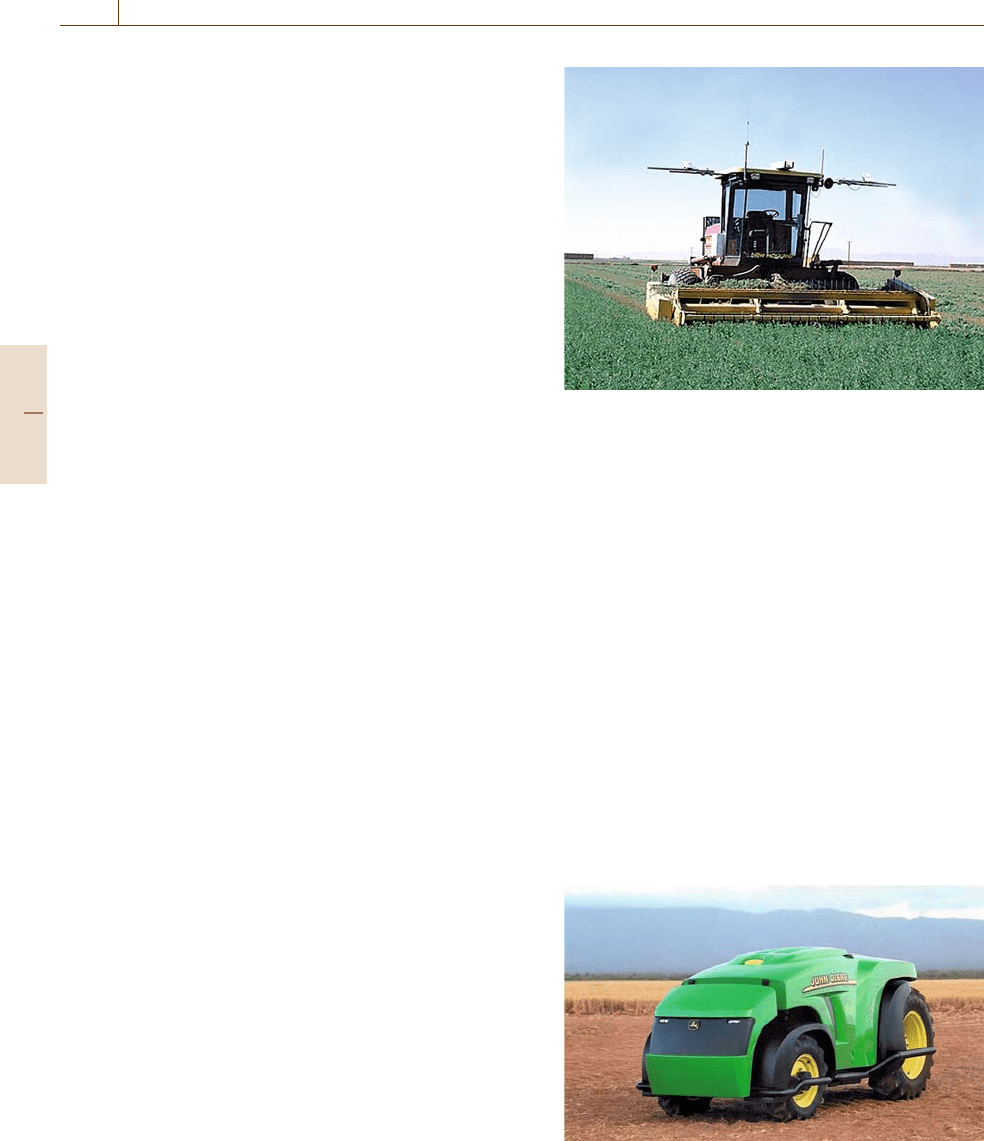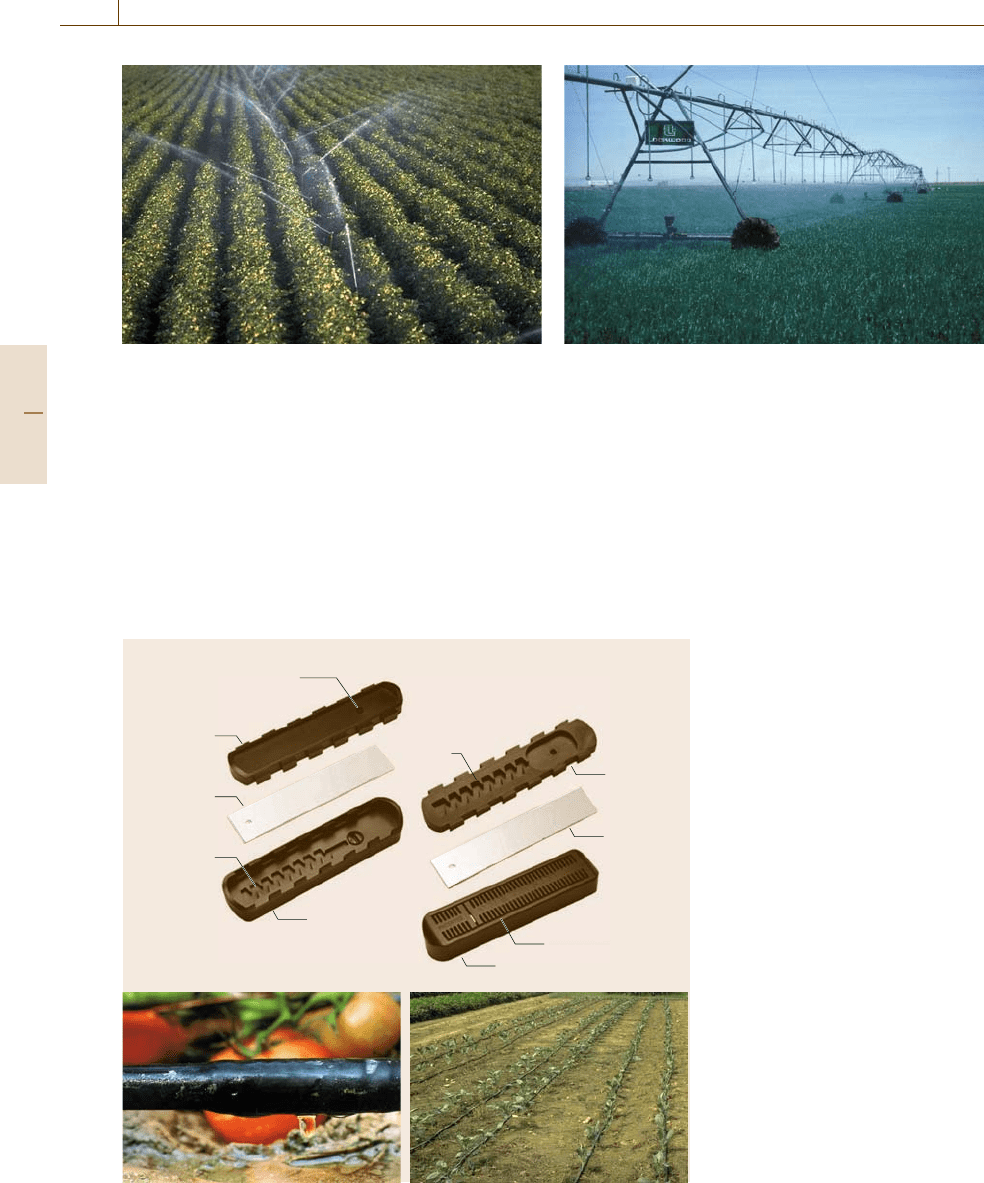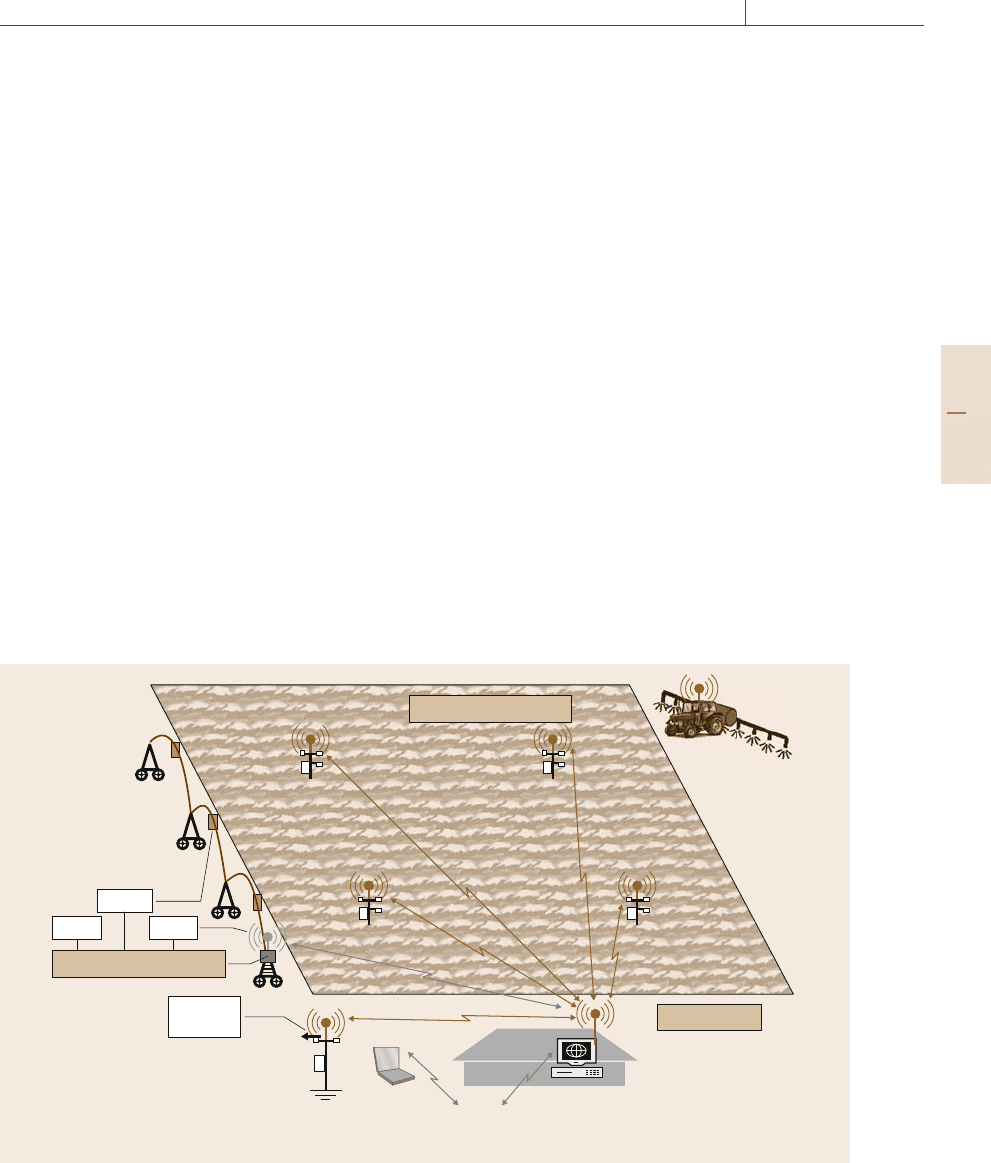Nof S.Y. Springer Handbook of Automation
Подождите немного. Документ загружается.


1095
Automation i
63. Automation in Agriculture
Yael Edan, Shufeng Han, Naoshi Kondo
The complex agricultural environment combined
with intensive production requires develop-
ment of robust systems with short development
time at low cost. The unstructured nature of
the external environment increases chances
of failure. Moreover, the machines are usually
operated by low-tech personnel. Therefore, in-
herent safety and reliability is an important
feature. Food safety is also an issue requir-
ing the automated systems to be sanitized and
reliable against leakage of contaminations.
This chapter reviews agricultural automation
systems including field machinery, irrigation
systems, greenhouse automation, animal au-
tomation systems, and automation of fruit
production systems. Each section describes the
different automation systems with many ap-
plication examples and recent advances in the
field.
63.1 Field Machinery....................................1096
63.1.1 Automatic Guidance
of Agricultural Vehicles ............... 1096
63.1.2 Autonomous Agricultural Vehicles
and Robotic Field Operations ....... 1099
63.1.3 Future Directions and Prospects ... 1101
63.2 Irrigation Systems.................................1101
63.2.1 Types of Irrigation Systems .......... 1102
63.2.2 Automation in Irrigation Systems . 1103
63.3 Greenhouse Automation .......................1104
63.3.1 Climate Control .......................... 1104
63.3.2 Seedling Production ................... 1106
63.3.3 Automatic Sprayers..................... 1109
63.3.4 Fruit Harvesting Robots............... 1109
63.4 Animal Automation Systems ..................1111
63.4.1 Dairy ........................................ 1111
63.4.2 Aquaculture............................... 1114
63.4.3 Poultry...................................... 1115
63.4.4 Sheep and Swine ....................... 1115
63.5 Fruit Production Operations...................1116
63.5.1 Orchard Automation Systems ....... 1116
63.5.2 Automation of Fruit Grading
and Sorting ............................... 1118
63.6 Summary .............................................1121
References ..................................................1122
Agricultural productivity has significantly increased
throughout the years through intensification, mech-
anization, and automation. This includes automated
farming equipment for field operations, animal sys-
tems, andgrowingsystems (greenhouseclimate control,
irrigation systems). Introduction of automation into
agriculture has lowered production costs, reduced the
drudgery of manual labor, raised the quality of fresh
produce, and improved environmental control. Unlike
industrial applications, which deal with simple, repeti-
tive, well-defined, and a priori known tasks, automation
in agriculture requires advanced technologies to deal
with the complex and highly variable environment
and produce. Agricultural products are natural objects
which have a high degree of variability as a result
of environmental and genetic variables. The agricul-
tural environment is complex and loosely structured
with large variations between fields and even within the
same field. Fundamental technologies must be devel-
oped to solve difficult problems such as continuously
changing conditions, variability in products and en-
vironment (size, shape, location, soil properties, and
weather), delicate products, and hostile environmen-
tal conditions (dust, dirt, and extreme temperature and
humidity). Intelligent control systems are necessary
for dynamic, real-time interpretation of the environ-
ment and the objects. When compared with industrial
automation systems, precision requirements in agricul-
Part G 63

1096 Part G Infrastructure and Service Automation
tural automation systems may be much lower. Since the
product being dealt with is of relative low cost, the cost
of the automated system must be low in order for it to
be economically justified. The seasonal nature of agri-
culture makes it difficult to achieve the high utilization
found in manufacturing industries.
63.1 Field Machinery
The use of machinery in agriculture has a long his-
tory, but the most significant developments occurred
during the 20th century with the introduction of trac-
tors. As early as 1903, the first farm tractor powered by
an internal combustion engine was built by Hart Parr
Company. Using its assembly line techniques, Henry
Ford & Son Corporation started mass production of
Fordson tractors in 1917. The commercial success of
tractors sparked other innovations as well. In 1924, the
International Harvester Company introduced a power
takeoff device that allowed power from a tractor en-
gine to be transmitted to the attached equipment such
as a mechanical reaper. Deere & Company followed
in 1927 with a power lift device that raised and low-
ered hitched implements at the end of each row. Rubber
wheels were first designed and used for tractors in
1932 to improve traction and fuel economy. Pulled
and powered by tractors, an increasingly wide range
of farm implements were developed in the 20th cen-
tury to mechanize crop production in every step, from
tillage, planting, to harvesting. Harvesting equipment
trailed only tractors in importance. Early harvesters for
small-grain crops were pulled by tractors and powered
by tractors’ power takeoff (PTO). The development of
a self-propelled combine in 1938 by Massey Harris
marked a significant progress in increasing productiv-
ity. The self-propelled combine incorporated several
functions such as vehicle propulsion, grain gathering,
and grain threshing into an all-in-one unit for better
operation efficiency. The mechanization of harvesting
other crops included the developments of mechani-
cal hay balers in the 1930s and mechanical spindle
cotton pickers in 1943. Tractors, combines, and other
farm machinery were continuously refined during the
second half of the 20th century to be more efficient,
productive, and user-friendly. The success of agricul-
tural mechanization has built a strong foundation for
automation. Automation increases the productivity of
agricultural machinery by increasing efficiency, relia-
bility, and precision, and reducing the need of human
intervention [63.1]. This is achieved by adding sensors
and controls. The blending of sensors with mechanical
actuation can be found in many agricultural operations
such as automating growing conditions, vision-guided
tractors, product grading systems, planters and har-
vesters, irrigation, and fertilizer applicators. The history
of automation for agricultural machinery is almost as
old as agricultural mechanization. Two ingenious ex-
amples in the early 20th century were the self-leveling
system for hillside combines by Holt Co. in 1891
and the implement draft control system by Fergu-
son in 1925 [63.2]. Early automation systems mainly
used mechanical and hydromechanical control devices.
Since the 1960s, electronics development for monitor-
ing and control has dominated machine designs, and
has led to increased machinery automation and intelli-
gence. Mechatronics technology, a blend of mechanics,
electronics, and computing, is often applied to the de-
sign of modern automation systems. Automation in
contemporary agricultural machines is more compli-
cated than a single control action; for example, the
modern combine harvester has automatic control of
header height, travel speed, reel speed, rotor speed,
concave opening, and sieve opening to optimize the en-
tire harvest process. Farm machinery includes tractors
and transport vehicles, tillage and seeding machines,
fertilizer applicators and plant protection application
equipment, harvesters, and equipment for post-harvest
preservation and treatment of produce. Mechanization
and automation examples can be found in many of these
machines [63.3]. However, the wide variety of agricul-
tural systems and their diversity throughout the world
makes it difficult to generalize about the application of
automation and control [63.1]. Therefore, only one type
of automation – automated navigation of agricultural
vehicles – will be presented here. Automated vehicle
navigation systems include the operator-assisted steer-
ing system, automatic steering system, and autonomous
system. These systems can relieve the vehicle opera-
tor of the repetitive and monotonous steering operation.
Automatic guidance has been the most active research
area in the automation history of agriculturalmachinery.
With the introduction of the global positioning system
(GPS) to agriculture in the late 1980s, automatic guid-
ance technology has been successfully commercialized.
Today, autoguidance is the fastest growing segment in
the agricultural machinery industry. The following sec-
tions discuss theprinciples of autoguidance systems, the
Part G 63.1

Automation in Agriculture 63.1 Field Machinery 1097
availabletechnologies, and examplesof specificautogu-
idance systems.
63.1.1 Automatic Guidance
of Agricultural Vehicles
For many agricultural operations, an operator is re-
quired to perform two basic functions simultaneously:
steering the vehicle and operating the equipment. The
need to relieve the operator of continuously making
steering adjustments has been the main reason for the
development of automatic guidance systems. Excellent
references to automatic vehicle guidance research in
Canada, Japan, Europe, and the USA can be found in
Wilson [63.4], Torii [63.5], Keicher and Seufert [63.6],
and Reid et al. [63.7]. Figure 63.1 shows a typical au-
toguidance system which includes a position sensor,
a steering angle sensor, and a steering actuator as the
hardware components, and a path planner, a navigation
controller, and a steering controller as the software com-
ponents. The path planner givesthe desired (or planned)
vehicle position. This desired position is compared with
the measured position given by the position sensor.
The navigation controller calculates the desired steering
control angle based on the difference in the desired and
measured positions. Finally, the steering controller uses
the difference in the desired and measured steering an-
gles to calculatean implementing steeringcontrol signal
and sends it to drive the steering actuator. Modern agri-
cultural vehicles often employ electrohydraulic (E/H)
steering systems. Developments in each of the system
components are described in details below.
Position Sensing
The position sensing system measures vehicle posi-
tion relative to a reference frame and provides inputs
to the navigation controller. Most agricultural guidance
applications require position measurement in two-
dimensional (2-D) space. In addition, vehicle speed,
heading, and rotational movements (roll, pitch,yaw) are
often needed by the navigation controller.
Guidance accuracy is the primary factor in select-
ing a position sensor. Auernhammer and Muhr [63.8]
suggested three levels of accuracy required for differ-
ent farming operations: 1 m for rough operations (soil
sampling, weed scouting), 10cm for fine operations
(pesticide application, soil cultivation), and 1cm for
precise operations (planting, plowing). Different po-
sition sensors are selected in a guidance system to
meet the accuracy requirements for different farming
operations. In general, there are three categories of
Position
sensor
Navigation
controller
Path
planner
Hardware
Software
Measured
position
Steering angle
sensor
Steering
controller
Measured
angle
Desired
position
Desired
control
Steering
actuator
Fig. 63.1 Components of a typical autoguidance system
positioning techniques: absolute positioning, relative
positioning, and sensor fusion.
Absolute Positioning. The most common system of
absolute positioning is the global navigation satellite
system (GNSS). Currently, the NAVSTAR global po-
sitioning system (GPS) in the USA is the only fully
operational GNSS.AGPS receiver calculates its po-
sition by measuring the distance between itself and
three or more GPS satellites. The positioning accuracy
of an autonomous, mobile GPS receiver is 5–15m.
This accuracy is generally not suitable for vehicle guid-
ance. To improve the accuracy, a differential correction
technique is applied. A differential GPS (DGPS) re-
ceiver can provide position accuracy within 2–5m
and within 1m precision in a short time period. The
DGPS receiver’s accuracy can meet the requirement
of positioning accuracy for most guidance applica-
tions. Further improvement in GPS accuracy requires
carrier-phase enhancement (or a real-time kinematic
process), typically using a local base station. The real-
time kinematic GPS (RTK GPS) receiver can achieve
centimeter accuracy and should meet the positioning
accuracy requirements for almost all agricultural field
operations. The GPS positioning technique has been
successfully implemented for vehicle guidance since its
inception [63.9–12]. Otherabsolute positioning sensors,
such as laser [63.13] and geomagnetic direction sen-
sors [63.14], havebeen developedand appliedto vehicle
guidance with varying degrees of success. However,
currently the GPS receiver remains the only commer-
cially viable choice for absolute positioning systems.
Relative Positioning. The most promising system of
relative positioning is computer vision using cam-
Part G 63.1

1098 Part G Infrastructure and Service Automation
eras [63.4]). Vision-based sensing is mainly used for
automatic guidance in row crops. Its operation resem-
bles a human operator’s steering of the vehicle – the
camera is equivalent to the eye and the vision pro-
cessor is equivalent to the brain. The main technical
challenge to vision guidance is using image process-
ing to find a guidance directrix, i.e., the position
and orientation of the crop rows relative to the vehi-
cle. Numerous image recognition algorithms, such as
Bayes classification, edge detection, K-means cluster-
ing, and the Hough transform, have been developed
since the 1980s [63.15–19]. Vision-based system can
achieve excellent positioning accuracy under good crop
and ambient light conditions; for example, Billings-
ley and Schoenfisch [63.20] reported 2cm accuracy for
their vision guidance systems. Han et al. [63.19] re-
ported 1.0 cm average root-mean-square (RMS)offset
error for soybean images and 2.4cm for corn images.
However, the vision-based system may not be reliable
under changing lighting conditions, which are not un-
common in an agricultural environment. Other relative
positioning sensors include dead reckoning, odometry,
and inertial measurement units (IMU). These sensors
are seldom used alone in a vehicle navigation system.
Instead, they are integrated with absolute positioning
sensors (e.g., GPS) in a sensor fusion approach.
Sensor Fusion. Sensor fusion is the process of com-
bining data from multiple sensors so that the resulting
information is better than when these sensors are used
individually. No single positioning sensor will work for
agricultural vehicle guidance under all conditions; for
example, a GPS signal may be blocked by heavy tree
shading. Vision sensors may not work under heavy dust
conditions. Sensor fusion not only provides a way to au-
tomatically switch to a working sensor when one of the
sensors quits working, but also blends the outputs from
the multiple working sensors to obtain the best results.
A good example of sensor fusion is integration of GPS
with inertial sensors [63.21]. In this approach, GPS pro-
vides the low-frequency absolute position information,
and inertial sensors provide the high-frequency rela-
tive position information. Inertial sensors can smooth
out the short-term GPS errors, and the GPS can correct
the bias and scale factor errors of the inertial sensors.
If the GPS signals become temporarily unavailable, the
inertial sensors can continue to provide position infor-
mation. Sensor fusion allows the integration of several
low-cost sensors to achieve good positioning accu-
racy [63.22]. Many algorithms are available for sensor
fusion [63.23], with the Kalman filtering technique
being the most common approach [63.24]. Adaptive
sensor fusion algorithms have also been developed to
deal with a priori unknown sensory distributions and
asynchronous update of the sensors [63.25]. Terrain
compensation is another example of applying sensor fu-
sion to improve guidance accuracy on sloping terrain.
A terrain compensation module measures vehicle roll,
pitch, and yaw angles, and combines these measure-
ments with the position measurement to compensate
for the GPS antenna movement due to side slopes
and rough terrain. Many manufactures of autosteering
systems now offer terrain compensation features. Addi-
tional information on sensor fusion can also be found
on Chap.20.
Path Planning
Path planning is the generation of 2-D sequenced po-
sitions or trajectories for the automated vehicle. The
sequenced positions account for the vehicle kinematics
such as the minimum turn radius and other constraints.
Most agricultural operations, such as tillage, planting,
spraying, and harvesting, require the vehicle to travel
the entire field with parallel paths at a fixed spacing
equaling the implement width. Planning such paths is
called coverage path planning. Coverage path planning
involves two steps. Step one is to decompose a field
into subregions. An optimal travel direction is found
for each subregion. Step two is to find the optimal
coverage pattern within each subregion. Many differ-
ent algorithms have been developed for coverage path
planning [63.26].
Trapezoidal decomposition is a popular technique
for subdividing the field. The trapezoids are then
merged into larger blocks and the selection is made us-
ing certain criteria which take into consideration the
area and the route length of the block and the efficiency
of driving [63.27]; Jin and Tang [63.28] used a geomet-
ric model to represent the full coverage path planning
problem. The algorithm was capable of finding a glob-
ally optimal decomposition for a given field and the
direction of the boustrophedon paths for each subre-
gion. The search mechanism of the algorithm is guided
by a customized cost function that unifies different cost
criteria, and a divide-and-conquer strategy is adopted.
A graphical approach is often used to find the opti-
mized coverage pattern within a subregion [63.29–31].
The processes include partitioning the area, building
a partition graph, and searching the partition graph.
Heuristic functions are used in the searching process to
prune the search tree early so the optimized solution can
be found within a reasonable time. In the case of mul-
Part G 63.1

Automation in Agriculture 63.1 Field Machinery 1099
tiple vehicles working in the same region, Gray [63.32]
developed a path planning method.
Navigation and Steering Controllers
The navigation controller takes the desired and meas-
ured positions as inputs to compute the desired control
variables, typically the lateral and heading corrections.
The desired control variables and the measured vari-
ables (typically the steering angle) are fed into the
steering controller to compute the steering corrections.
A typical navigation control algorithm calculates the
lateral and heading errors based on a reference point
on the vehicle and a target (look-ahead) point on the
desired vehicle trajectory. The target point may be
dynamically adjusted based on speed to achieve satis-
factory path tracking performance [63.33,34].
Agricultural vehicles frequently operatein challeng-
ing conditions such as varying travel speed, operating
load, and ground surface conditions. The steering con-
troller design must be robust enough to adapt to
these conditions. Several steering controllers, includ-
ing proportional–integral–differential (PID) controller,
feedforward PID (FPID) controller, and fuzzy-logic
(FL) controllers, have been developed and implemented
in the guidance system [63.35–37]. Additional infor-
mation on mobility and navigation can be found on
Chap.16.
Commercialization of Autoguidance Systems
Commercial development of autoguidance systems by
US manufacturers started in the 1990s soon after the
availability of GPS to agricultural applications. Early
GPS-based guidance systems used visual aids, com-
monly referred to as lightbars, to show a driver how to
steer the vehicle along parallel passes or swaths across
a field. The need to improve driving accuracy and re-
peatability led to the development of the next level
of automation – autosteering. The autosteering system
steers thevehicle within a path and the driver only needs
to turn at the ends. Several preset driving patterns can
be used by an autosteering system during field opera-
tions. Themost popularpatterns for ground applications
are straight rows and curved rows. The straight-row
option allows the operator to follow parallel straight
paths separated by a predetermined swath width. An
initial path (A–B line) is first defined by the operator
and the remaining paths are generated by the guidance
system. For the curved-row option, the operator drives
the first curved path. The autoguidance system steers
the vehicle along the consecutive paths. Other driv-
ing patterns such as circles (for center-pivot irrigation
EH steering system
Guidance controller GPS receiver
Fig. 63.2 A John Deere 8000 series tractor equipped with
the GreenStar AutoTrac assisted steering system
field) and spirals (for field headlands) are also available
in some autoguidance systems. Autoguidance systems
are now commercially available. Figure 63.2 shows an
example of the GreenStar AutoTrac assisted steering
system on a John Deere 8000 series tractor. Most auto-
guidance systems have reported a path-to-path accuracy
better than 5cm with DGPS or RTK under good field
conditions.
63.1.2 Autonomous Agricultural Vehicles
and Robotic Field Operations
An autonomous vehicle must be able to work without
an operator. In addition to steering, it must perform
other tasks that a human operator typically does: detect-
ing and avoiding unknown objects, operating at a safe
speed, and performing implement tasks while driving.
Developing human intelligence for the autonomous ve-
hicle is a challenging job.
Autonomous vehicles working in an unstructured
agricultural environment must use sophisticated sensing
and control systems to be able to react to any unplanned
events. A typical unplanned event is the presence of
a human or animal in front of the vehicle. Develop-
ment of vehicle safeguarding systems is the key to the
deployment of the autonomous vehicles. A number of
technologies have been investigated for providing vehi-
cle safeguarding. Guo et al. [63.38] used two ultrasonic
sensors to detect a human being. The reliable detec-
tionrangewasupto4.6 m for moving objects and
7.5m for stationary objects under field conditions. Wei
et al. [63.39] used a binocular stereo camera to detect
a person standing in front of a vehicle. The system was
Part G 63.1

1100 Part G Infrastructure and Service Automation
able to find the person’s relative motion status (speed
and heading) relative to the vehicle at a distance range
from 3.4to13.4m. Kise et al. [63.40] tried a laser
rangefinder to estimate the relative motion of a tractor
obstacle. In general, ultrasonic sensors are low cost but
their detection range is short. Stereo cameras are unreli-
able under changing lighting conditions. Currently, the
most reliable technology is the laser rangefinder, but its
use is limited to research vehicle platforms due to the
high costs. Multiple levels of system redundancy must
be designed into the vehicle, which often requires mul-
tiple safeguarding sensors. Developmentof robotic field
operations is an integral part of autonomous vehicles. In
order to use an autonomous vehicle, tasks must be au-
tomated as well. Over the years, agricultural equipment
has evolved to accommodate the automated control of
tasks [63.1]. Microprocessor-based electronics control
is replacing mechanical control, and electrohydrauli-
cally powered actuatorsare preferred over mechanically
powered ones. The adoption of CAN bus standards
(SAE J1939, DIN 9684, ISO 11783) in the agricultural
equipment industry has allowed networking of multiple
control systems.
Task automation examples can be found in many
modern agricultural machines. Examples include map-
based automatic spraying of fertilizer and chemicals
on sprayers, and headland management systems (HMS)
for automatic sequencing of tractor functions normally
associated with headland turns. Matsuo et al. [63.41]
described a tilling robot that was able to do tillage,
seedling, and soil paddling operations.
Reid [63.42] discussed a number of challenges
related to the development of intelligent agricultural
machinery and equipment. At present, autonomous
agricultural vehicles and roboticfield operationsare still
not reliable and durable enough to meet the require-
ments of the agricultural industry and its customers.
Nevertheless, a number of autonomous vehicle systems
have been developed as proof-of-concept machines
which may lead to commercialization in the future.
Some exemplary systems are briefly introduced below.
Robotic Harvester
A robotic harvester, called Demeter (Fig. 63.3), has
been developed by the Carnegie Mellon Univer-
sity Robotics Institute for automated harvesting of
windrowed crops. The robot platform was a New
Holland 2550 self-propelled windrower equipped with
DGPS, inertial navigation system (INS), and two color
cameras. The camera system detected the cut/uncut
edge of the crop, which gave a relative directrix for the
Fig. 63.3 The robotic harvester (Demeter) (courtesy of
Carnegie Mellon University)
harvester to follow. The camera system was also used
to detect potential obstacles for vehicle safeguarding.
GPS data was fused with vision data for guidance. In
addition to steering, speed and header height of the har-
vester were also automatically controlled. In 1997, the
Demeter autonomously harvested 100acres of alfalfa in
a continuous run (excluding stops for refueling). During
1998, the Demeter harvested in excess of 120acres of
crop, cutting in both sudan and alfalfa fields [63.43,44].
Autonomous Tractor
An autonomous tractor has been jointly developed by
John Deere and Autonomous Solutions Inc. for au-
tomated spraying, mowing, and tillage in orchards
(Fig.63.4). The robot platform was a John Deere
5000 series tractor with significant modifications. The
system components included the vehicle, a mobile con-
trol unit, and a base station; all were communicated
Fig. 63.4 A John Deere 5000N autonomous orchard trac-
tor (courtesy of Deere & Company)
Part G 63.1

Automation in Agriculture 63.2 Irrigation Systems 1101
by a wireless CAN system. A DGPS and INS were
used as positioning sensors. Vehicle controls included
steering, brake, clutch, three-point hitch, PTO,and
throttle. A long-range obstacle detection system was
proposed for vehicle safeguarding. One of the key de-
velopments in the project was the path and mission
planning, which included dynamic replanning for dy-
namic service events. The system design followed an
industry joint architecture for unmanned ground sys-
tems (JAUGS) architecture. A proof-of-concept system
was developed and successfully demonstrated, but the
production decision was not made, primarily due to
safety concerns.
Small Robotic Platforms
In agriculture, small robots can be used for many field
tasks such as collection of soil or plant samples and de-
tection of weed, insect or plant stress. When equipped
with a larger energy source and appropriate actua-
tors, they can also be used for localized treatments
such as spot-spraying of chemicals or mechanical in-
row weeding. A number of small robots have been
developed, mainly at universities and research insti-
tutes [63.45]. Astrand and Baerveldt [63.46] developed
an autonomous robot for mechanical weed control in
outdoor environments. The robot employs a grey-level
vision system to guide itself along the crop rows and
a second,color-basedvision systemto identify the weed
and to control a weeding tool that removes the weed
within the row of crops.A plant nursingrobot, HortiBot,
was developedin Denmarkas atool carrierfor precision
weeding [63.47–49]. The HortiBot is a radio-controlled
slope mower (Spider ILD01, Dvorák Machine Division,
Czech Republic) equipped with a robotic accessory kit.
A commercial stereo vision system was implemented
for automatic guidance within plant rows.
63.1.3 Future Directions and Prospects
Farm productivity has increased significantly during the
last century. Today, less than 3% of the US popula-
tion works in agriculture, yet they produce more than
adequate food for the entire nation. Agricultural mech-
anization has played a significant role in achieving this
miracle. As next steps to mechanization, automation
and robotization of farm operations can result in addi-
tional productivity improvement.
Autoguidance will continue to be the main fo-
cus of future development. The agricultural industry
is now developing new systems for automation be-
yond autosteering of vehicles. Implement guidance and
headland management are two examples. An imple-
ment guidance system automatically steers both tractor
and implement and keeps the implement on the de-
sired path. This helps overcome implement drift on
hillsides or contour field conditions. The headland man-
agement system automates implement controls (e.g.,
to raise or lower the implement) and makes automatic
turns at headland and interior field boundaries. Other
guidance technologies that are close to commercializa-
tion include: sensor fusion that employs a multitude of
complementary positioning sensors to improve system
reliability, path or mission planning that produces the
most efficient coverage paths fora single or multiple ve-
hicles, and leader–followersystems formultiple-vehicle
navigation and control, as in the case of combine har-
vester operation. Precision farming has become an area
of enormous growth and excitement since the 1980s.
The key concept in precision farming is to manage crop
production at the subfield level. The labor-intensive na-
ture of precision farming practices brings a great need
for automated machines and equipment. Yield mapping
and variable-rate application systems are now commer-
cially available. In the future, autonomous field scout
vehicles are needed for soil sampling, crop scouting,
and real-time data collection. Small robots are de-
sired for individual plant care such as precision weed
control and selective crop harvesting. Because preci-
sion farming is considered as the future of agriculture,
automation and robotics technologies will certainly
become a big part of production agriculture in the
21st century.
63.2 Irrigation Systems
Irrigation is the supplementalapplication of water to the
soil for assisting in growing crops. It is used mainly to
replace missing rainfall for field crops, and to supply
water to crops growing in protected environments such
as greenhouses. The main objective is to supply the re-
quired amount of water to the plants at the right time.
The types of irrigation techniques differ in how the wa-
ter is distributed within the field. In surface irrigation
systems water moves over the land by gravity and in-
filtrates into the soil. Surface irrigation systems include
Part G 63.2

1102 Part G Infrastructure and Service Automation
Fig. 63.5 Sprinkler irrigation (courtesy of US Fish and
Wildlife Service, USFWS/Elkins WV)
furrow, border-strip, and basin irrigation. Localized ir-
rigation systems distribute water in piped networks by
pressure, and the water is applied locally in the field
and to the plant. Localized systems include spray, sprin-
kler, drip, and bubble systems. Automation provides
efficient on-farm use of water and labor for all meth-
ods by enabling flexible frequency, rate, and duration
of water supply with control of the irrigator at the right
application point [63.50].
Top of dripper
Raised lip surrounding the exit hole,
along with the air gap between the
exit hole in the dripper and the tubing,
provides physical root barrier
Dripper cover
Diaphragm
Dripper base
Dripper base
Diaphragm
Dripper cover
Filtration surface
Full path
Flow path
Bottom of dripper
Fig. 63.7 Dripper and drip line irriga-
tion system (courtesy of Netafim)
Fig. 63.6 Center pivot with drop sprinklers (courtesy of
Conversation and Production Res. Lab., Bushland, TX,
USDA, ARS)
63.2.1 Types of Irrigation Systems
Flood control automation includes optimal gate oper-
ation of irrigation reservoirs [63.51]; surge flooding,
which enables release of water at prearranged intervals;
telemetering of paddy ponding depth and canal water
level [63.52], which can be used to capture runoff and
pump it back into the field for reuse; and precision con-
Part G 63.2

Automation in Agriculture 63.2 Irrigation Systems 1103
trol of inflow rate using ground-based remote-sensing
feedback control systems [63.53]. Position of the ad-
vance of water along the furrow can be determined by
contact-type sensors manually positioned in the furrow
and recently by imaging systems [63.53,54].
In sprinkler irrigation, water is piped to several lo-
cations in the field and distributed by high-pressure
sprinklers or guns (Fig. 63.5). Spatially variable ir-
rigation systems have typically used self-propelled
irrigation systems – sprinklers mounted on moving
platforms or center pivots [63.56, 57]. Center-pivot
irrigation is a sprinkler irrigation system that is com-
posed of several pipe segments joined together that are
mounted on wheeled towers with sprinklers positioned
along its length (Fig.63.6). The system moves in a cir-
cular pattern.
Drip irrigation systems (Fig. 63.7) were invented in
Israel in 1965. Water is applied slowly and directly
to the soil, and only where needed. A drip irriga-
tion system consists of valves, back-flow preventers,
pressure regulators, filters, emitters, and of course the
pipes (the mainline that leads water from the source to
the valve, and the subpipe that goes from the valves
to the connection point of the drip tubing and the
drip tubes). Low-head bubbler irrigation systems are
micro-irrigation systems based on gravity flow that
In-field sensing station
Base station
Internet
• Sensing
- soil moisture
- soil temperature
- air temperature
• Power
- 12V battery
- solar panel
- voltage regulator
• Communication
- Bluetooth radio transmitter
• Input
- in-field data
- off-field data
• Processing
- decision making
• Output
- site/time-specific
irrigation amount
Irrigation control station
Relay
RadioGPS
Weather
station
• Input sensing
- GPS
- Freeport to PC
• Output: control
- solenoids
via relay
• Sensing
- air temp. & RH
- precipitation
- wind speed, direction
- solar radiation
Fig. 63.8 Wireless irrigation system conceptual layout (after [63.55])
operate at low pressure and require no filtration or
pumping [63.58]. Their main advantages are simplicity,
lower energy requirements, and few mechanical break-
downs[63.58]. However, theirapplication is limited due
to the complicated design and installation problems.
63.2.2 Automation in Irrigation Systems
Automation systems include irrigation time clocks
– mechanical and electromechanical timers to allow
accurate control of water responding to environmen-
tal changes and plant demands [63.59], with recent
advances in using sensors to measure soil proper-
ties such as moisture and salinity using resistance-
and capacitance-based sensors, and time-domain re-
flectometry [63.60, 61]. Sensors for measuring plant
stress [63.62] by scanned and spotted canopy tem-
perature measurements have been used in scheduling
decisions for center-pivot and subsurface drip irrigation
systems [63.63]. Sensors include infrared thermome-
ters, thermal scanner sensors, and multispectral imag-
ing [63.64].
High-resolution data of soil and water dynamics
coupled with measurement of crop response to salinity
and water stress are important for irrigation manage-
ment optimization [63.65]. These data are commonly
Part G 63.2

1104 Part G Infrastructure and Service Automation
provided by weight-based soil lysimeters, with recent
development of a volumetric lysimeter system [63.65].
Developments in automated irrigation systems in-
clude scheduling programs that use weather data to
recommend and control time and amount of irrigation,
crop growth stage and water/nutrients needs detected in
real time, and commercial yield monitors and remote
sensors to map crop production precisely. An example
includes a real-time irrigation scheduling program for
supplementary irrigation that includes a reference crop
evapotranspiration model, an actual evapotranspiration
model, a soil water balance model, and an irrigation
forecast model, all combined using a mixed linear pro-
gram [63.67,68].
Low-cost microprocessor and infrared sensor
systems for automating water infiltration measure-
ments [63.69] are important in controlling crop yields
and delivering water and agricultural chemicals to soil
profile. Control of nutrients with sensors enables op-
timization of irrigation and fertilization management
systems, useful for reducing environmental impact
caused by runoff of nutrients into surfaces and ground-
water by using ion-sensitive field-effect sensors [63.70].
A wireless in-field sensor-based irrigation manage-
ment system was developed to provide variable-rate
irrigation. Variable-rate irrigation was controlled by
a computer that sends control signals to irrigation con-
trollers via real-time wireless communications based
on field information and GPS positions of sprin-
klers [63.55,66,71,72].A self-propelled linear sprinkler
system equipped with a DGPS and a program logic
controller was remotely controlled by a base com-
puter [63.72,73], using a closed-loop irrigation system
to determine the amount of irrigation based on dis-
tributed soil water measurements (Figs. 63.8 and 63.9).
The system was operated by a program logic controller
that controlled solenoids to turn sprinkler nozzles on
and off. Variable-rate application was implemented by
regulating pressure into a group of nozzles.
Five in-field sensing stations Weather station
Fig. 63.9 Five in-field sensing stations and weather station
mounted on the linear irrigation cart (after [63.66])
To control small areas in field irrigation, solid-set
sprinkler and micro-irrigation can be controlled using
centralized or distributed irrigation controls [63.74].
Architectures of distributed sensor networks for site-
specific irrigation automation combining smart soil
moisture sensors and sprinkler valve controllers have
been developed [63.75] and are commercially avail-
able (e.g., Irriwise, Netafim). This can be expanded
to closed-loop control for automated irrigation based
on in-field sensing feedback of plant and soil condi-
tions. Further developments include spot-spraying of
herbicides based on real-time weed detection using
optical sensors. Growers using recirculating systems
often choose to sterilize the drain water before send-
ing it back to the plants. One of the following
two methods is often used: ultraviolet (UV) ster-
ilization or ozone sterilization. Automated real-time
polymerase chain reaction (PCR) system for detect-
ing pathogens in irrigation water has been devel-
oped [63.76].
63.3 Greenhouse Automation
The greenhouse environment is a relatively easy envi-
ronment for introductionof automatedmachinery dueto
its structured nature. Hence, the automated system must
deal only with the variability of the agricultural prod-
uct. Therefore, the development of systems is easier
and simpler. Automation systems for greenhouses deal
with climate control, seedling production, spraying, and
harvesting as detailed in the following sections.
63.3.1 Climate Control
Greenhouses have been developed during the 20th cen-
tury to keep solar radiation energy, to protect products
from various hazardous natural climates and insects,
and to produce suitable environments for plants by
use of 100μm plastic film or 2–3mm glass plates.
Advances in sensors and microcomputers have led to
Part G 63.3
